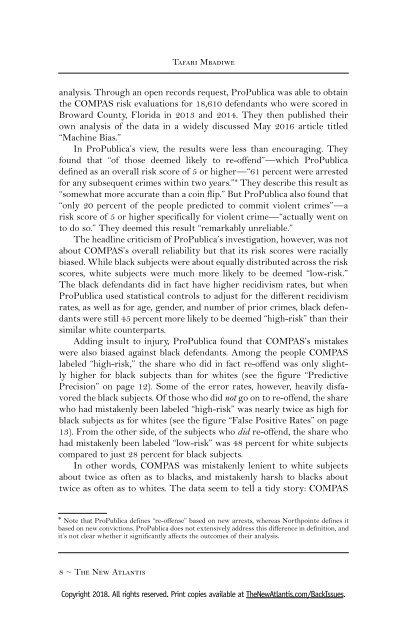The New Atlantis - Winter 2018 (Issue 54) uncompressed with cover
Create successful ePaper yourself
Turn your PDF publications into a flip-book with our unique Google optimized e-Paper software.
Tafari Mbadiwe<br />
analysis. Through an open records request, ProPublica was able to obtain<br />
the COMPAS risk evaluations for 18,610 defendants who were scored in<br />
Broward County, Florida in 2013 and 2014. <strong>The</strong>y then published their<br />
own analysis of the data in a widely discussed May 2016 article titled<br />
“Machine Bias.”<br />
In ProPublica’s view, the results were less than encouraging. <strong>The</strong>y<br />
found that “of those deemed likely to re-offend” — which ProPublica<br />
defined as an overall risk score of 5 or higher — “61 percent were arrested<br />
for any subsequent crimes <strong>with</strong>in two years.” * <strong>The</strong>y describe this result as<br />
“somewhat more accurate than a coin flip.” But ProPublica also found that<br />
“only 20 percent of the people predicted to commit violent crimes” — a<br />
risk score of 5 or higher specifically for violent crime — “actually went on<br />
to do so.” <strong>The</strong>y deemed this result “remarkably unreliable.”<br />
<strong>The</strong> headline criticism of ProPublica’s investigation, however, was not<br />
about COMPAS’s overall reliability but that its risk scores were racially<br />
biased. While black subjects were about equally distributed across the risk<br />
scores, white subjects were much more likely to be deemed “low-risk.”<br />
<strong>The</strong> black defendants did in fact have higher recidivism rates, but when<br />
ProPublica used statistical controls to adjust for the different recidivism<br />
rates, as well as for age, gender, and number of prior crimes, black defendants<br />
were still 45 percent more likely to be deemed “high-risk” than their<br />
similar white counterparts.<br />
Adding insult to injury, ProPublica found that COMPAS’s mistakes<br />
were also biased against black defendants. Among the people COMPAS<br />
labeled “high-risk,” the share who did in fact re-offend was only slightly<br />
higher for black subjects than for whites (see the figure “Predictive<br />
Precision” on page 12). Some of the error rates, however, heavily disfavored<br />
the black subjects. Of those who did not go on to re-offend, the share<br />
who had mistakenly been labeled “high-risk” was nearly twice as high for<br />
black subjects as for whites (see the figure “False Positive Rates” on page<br />
13). From the other side, of the subjects who did re-offend, the share who<br />
had mistakenly been labeled “low-risk” was 48 percent for white subjects<br />
compared to just 28 percent for black subjects.<br />
In other words, COMPAS was mistakenly lenient to white subjects<br />
about twice as often as to blacks, and mistakenly harsh to blacks about<br />
twice as often as to whites. <strong>The</strong> data seem to tell a tidy story: COMPAS<br />
* Note that ProPublica defines “re-offense” based on new arrests, whereas Northpointe defines it<br />
based on new convictions. ProPublica does not extensively address this difference in definition, and<br />
it’s not clear whether it significantly affects the outcomes of their analysis.<br />
8 ~ <strong>The</strong> <strong>New</strong> <strong>Atlantis</strong><br />
Copyright <strong>2018</strong>. All rights reserved. Print copies available at <strong>The</strong><strong>New</strong><strong>Atlantis</strong>.com/Back<strong>Issue</strong>s.


